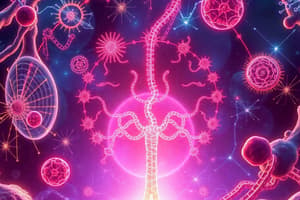Podcast
Questions and Answers
What happens in step one of the Krebs cycle?
What happens in step one of the Krebs cycle?
Pyruvate is broken down.
What occurs in step two of the Krebs cycle?
What occurs in step two of the Krebs cycle?
Coenzyme A bonds to the two-carbon molecule.
What is formed in step three of the Krebs cycle?
What is formed in step three of the Krebs cycle?
Citric acid is formed.
What happens in step four of the Krebs cycle?
What happens in step four of the Krebs cycle?
What takes place in step five of the Krebs cycle?
What takes place in step five of the Krebs cycle?
What occurs in step six of the Krebs cycle?
What occurs in step six of the Krebs cycle?
Flashcards are hidden until you start studying
Study Notes
Steps of the Krebs Cycle
- The Krebs cycle begins when pyruvate, a product of glycolysis, is broken down to initiate the process.
- Coenzyme A attaches to a two-carbon molecule, facilitating its entry into the Krebs cycle as an intermediate.
- A combination of the two-carbon molecule with a four-carbon molecule results in the formation of citric acid.
- The breakdown of citric acid leads to the production of NADH, a key electron carrier in cellular respiration.
- As the cycle progresses, a five-carbon molecule is formed and subsequently broken down, producing both NADH and ATP, which are crucial for energy transfer in the cell.
- A four-carbon molecule is rearranged in the cycle, resulting in the production of NADH and FADH2, both essential for the electron transport chain.
Studying That Suits You
Use AI to generate personalized quizzes and flashcards to suit your learning preferences.




